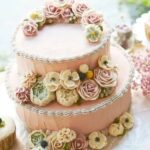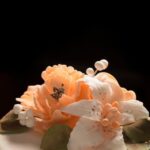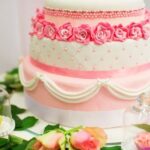In the world of cake decorating, there are endless possibilities when it comes to creating stunning and aesthetically pleasing designs. From intricate piping patterns to elaborate fondant sculptures, bakers are constantly pushing the boundaries of creativity. One trend that has gained significant popularity in recent years is the use of real flowers as cake decorations.
The idea of incorporating delicate blooms onto a sweet confection brings a touch of natural elegance and beauty to any occasion. But can you use real flowers to decorate a cake? In this article, we will explore this question and delve deeper into the art of using real flowers as cake decorations.
When it comes to decorating cakes with real flowers, there are important factors to consider, particularly the safety aspects. While some types of flowers may be edible and safe for consumption, others can be toxic if ingested. In the second section of this article, we will explore these safety factors in detail and provide guidelines on choosing blooms that are safe for cake decoration.
Not all flowers are suitable for adorning cakes, so in the third section, we will discuss various types of real flowers that are ideal for this purpose. From classic roses to vibrant pansies, there is a wide range of options available that can create stunning floral arrangements on your beautiful cakes.
As we embark on this exploration into the world of using real flowers as cake decorations, it is vital to understand how to properly prepare and clean them before placing them on a cake. The fourth section will guide you through step-by-step instructions on how to handle and sanitize real flowers so that they not only look beautiful but also remain safe for consumption.
The allure of adorning cakes with delicate blossoms lies not only in their aesthetics but also in the techniques used to attach them securely without compromising the design or taste. In the following sections, we will discuss different techniques and tips for attaching real flowers onto cakes effectively.
From simple and romantic designs to opulent and elegant arrangements, the possibilities are endless. You can create stunning cake creations that complement any occasion or theme. In section six, we will explore various cake designs using real flowers that evoke a sense of romance and sophistication.
The colors of the flowers used on a cake play a crucial role in creating a cohesive and visually pleasing design. Section seven will provide tips on how to match real flower colors with different cake themes, allowing you to achieve a harmonious and eye-catching result.
Finally, in the last section, we will address common questions and concerns that many people may have when it comes to using real flowers on cakes. We will answer frequently asked questions about their longevity, storage, and additional precautions you may need to consider before incorporating these natural adornments into your baked creations.
Using real flowers as cake decorations is an exquisite way to enhance the beauty of your edible masterpieces. From the safety factors involved to the techniques for attaching them, this article will guide you through every step of the process. So let’s dive in and uncover the world of real flower decorations for cakes.
Exploring the Safety Factors of Using Real Flowers on Cakes
Real flowers can add a touch of natural beauty and elegance to cake decorations. However, it is important to consider the safety factors before using real flowers on cakes. This section will explore the potential risks and how to ensure that real flowers are safe for consumption.
Understanding Potential Risks
When using real flowers on cakes, one must be aware of potential risks such as pesticide residues, allergic reactions, and toxicity. Most commercially grown flowers are treated with pesticides, which can be harmful if ingested. It is important to source organic or food-safe flowers to eliminate this risk.
Another risk is allergic reactions. Some individuals may have allergies or sensitivities to certain types of flowers. It is crucial to check with guests about any known allergies before decorating the cake with specific flower varieties.
Toxicity is another concern when using real flowers on cakes. Certain flowers contain toxins that can be harmful if consumed in large quantities. For example, species like lily-of-the-valley, foxglove, and oleander are toxic and should never be used for cake decorations.
Ensuring Safe Flower Selection
To ensure the safety of real flower decorations on cakes, it is essential to choose edible and non-toxic blooms. There are several types of flowers that are considered safe for cake decoration purposes:
- Roses: These classic flowers are not only beautiful but also safe for consumption.
- Calendula: Also known as marigold, these vibrant orange or yellow blossoms add a colorful touch without any toxicity concerns.
- Violets: The delicate viola blooms come in various colors and flavors, making them a popular choice for decorating cakes.
- Lavender: With its fragrant aroma and lovely purple color, lavender can enhance both the appearance and taste of a cake.
It is advisable to research the specific flower varieties being used and consult with professionals or florists knowledgeable about edible flowers to ensure safety.
Preparation and Cleaning Methods
Proper preparation and cleaning of real flowers are crucial to remove any potential contaminants. Start by selecting fresh, pesticide-free flowers from a reputable source. Remove any leaves, thorns, or other non-edible parts before using them on the cake.
To clean the flowers, gently rinse them under cold water to remove dirt or debris. Be careful not to soak the blossoms, as this can cause them to wilt or lose their vibrancy. Pat dry with a paper towel and allow them to air dry completely before using them for decorations.
By understanding the potential risks, selecting safe flower varieties, and following proper cleaning techniques, it is possible to use real flowers on cakes without compromising safety. The next section will delve into various techniques for attaching these delicate blooms securely onto cakes.
Types of Real Flowers That Are Safe for Cake Decoration
One of the important factors to consider when using real flowers for cake decoration is their safety. While many types of flowers are safe for use on cakes, there are also some that can be toxic and should be avoided. It’s crucial to choose flowers that are non-toxic, free from pesticides, and grown without the use of harmful chemicals.
There are several types of real flowers that are commonly used for cake decorations due to their safety and appealing appearance. Some popular choices include roses, lavender, violets, pansies, chamomile, daisies, and marigolds. These flowers not only add beauty to the cake but also create a pleasant aroma.
When selecting flowers for cake decoration, it’s important to ensure they have been grown specifically for culinary purposes. This means they have been raised without the use of pesticides or other harmful chemicals. It is recommended to source these flowers from reputable suppliers who specialize in providing edible flowers.
In addition to choosing safe flower varieties, it is essential to properly prepare and clean them before using them on a cake. Flowers should be examined carefully for any blemishes or signs of decay before being used as cake decorations. They should also be thoroughly washed with water to remove any dirt or debris.
| Flower Type | Description |
|---|---|
| Roses | A classic choice with various colors available. |
| Lavender | Known for its soothing fragrance and purple hue. |
| Violets | Small and delicate blooms that come in vibrant shades. |
| Pansies | Available in a wide range of colors and have a unique appearance. |
| Chamomile | Tiny, daisy-like flowers with a mild and sweet aroma. |
| Daisies | A symbol of purity and innocence, they add a cheerful touch to cakes. |
| Marigolds | Brightly colored blooms that bring vibrancy to cake designs. |
By selecting the right types of real flowers for cake decoration, you can enhance the visual appeal of your creations while ensuring the safety of those who will be enjoying them. It’s important to research and identify safe flower varieties before using them on cakes and follow proper cleaning procedures to maintain hygiene standards.
How to Properly Prepare and Clean Real Flowers for Cake Decorations
Real flowers can be a stunning and unique addition to cake decorations, but before using them, it is important to properly prepare and clean the flowers to ensure they are safe for consumption. This section will outline steps on how to prepare and clean real flowers for cake decorations.
To begin, it is crucial to use only edible flowers that are pesticide-free. It is recommended to either grow your own flowers or purchase them from a trusted source that specializes in edible flowers. Before using the flowers, make sure to remove any stems or leaves that are not safe for consumption.
Once you have selected your edible flowers, the next step is to properly clean them. Start by gently washing the flowers under lukewarm water to remove any dirt or debris. Be careful not to handle the delicate petals roughly as they can easily bruise or wilt.
After washing the flowers, soak them in a bowl of cold water for about 15 minutes. This will help remove any lingering dirt or insects. At this stage, it is important to inspect each flower carefully and discard any damaged or wilted ones.
After soaking, transfer the flowers onto a paper towel-lined plate and pat them dry with another paper towel. It is essential to ensure that all excess moisture has been removed from the flowers as moisture can cause the cake’s icing to dissolve or become soggy.
Now that you have properly prepared and cleaned your real flowers, they are ready to be used as cake decorations. Proceed with caution when handling the delicate petals during attachment so as not to damage them.
By following these guidelines on how to properly prepare and clean real flowers for cake decorations, you can confidently add a touch of natural beauty and elegance to your cakes without compromising safety.
| Step | Description |
|---|---|
| Choose Edible Flowers | Select only edible flowers that are pesticide-free and remove any stems or leaves that are not safe for consumption. |
| Wash the Flowers | Gently wash the flowers under lukewarm water to remove dirt and debris. Be gentle to avoid bruising or wilting the petals. |
| Soak in Cold Water | Soak the flowers in a bowl of cold water for 15 minutes to eliminate any remaining dirt or insects. |
| Paper Towel Drying | Transfer the flowers onto a paper towel-lined plate and pat them dry with another paper towel, ensuring all excess moisture is removed. |
Techniques for Attaching Real Flowers to Cakes
Using real flowers to decorate a cake can add a touch of elegance and natural beauty. However, it is important to properly attach the flowers to ensure they stay in place and do not contaminate the cake. Here are some techniques for attaching real flowers to cakes:
- Flower Picks: One common method is to use flower picks or flower spikes. These are small, pointed sticks that can be inserted into the stem of the flower, providing stability and preventing it from falling off the cake.
To use this technique, gently insert the pick into the base of the flower’s stem, making sure it goes in far enough for secure attachment. Then, carefully insert the pick into the cake at an angle or vertically. - Floral Tape: Another option is to use floral tape, which is a self-adhesive tape specifically designed for securing flowers and foliage together. To attach flowers using this method, wrap a small piece of floral tape around the base of each flower‘s stem until it is securely affixed. Then, gently press the taped stem into the cake at a desired angle or position.
- Edible Glue: If you prefer not to use any non-edible materials on your cake, edible glue can be used to secure real flowers. Edible glue can be made using ingredients like tylose powder or gum paste mixed with water. Apply a small amount of edible glue onto the flower’s stem or petals using a brush or toothpick before placing it on the cake.
It is important to note that when attaching real flowers to cakes, you should avoid inserting them directly into the cake without any barrier or support as certain flowers may contain harmful substances. By utilizing these techniques, you can safely incorporate real flowers into your cake design while ensuring proper attachment and presentation.
Remember that not all flowers are safe for direct contact with food surfaces due to pesticides or other chemicals used during their cultivation. Make sure to properly clean and prepare the flowers before attaching them to the cake, as outlined in the previous section of this article. With the right techniques and precautions, you can create stunning cake designs using real flowers that will impress your guests.
Romantic and Elegant Cake Designs Using Real Flowers
Real flowers can add a touch of romance and elegance to any cake design. Whether you are planning a wedding, anniversary, or special event, using real flowers as decorations can create a stunning and memorable centerpiece. In this section, we will explore some creative and beautiful cake designs that incorporate real flowers.
Cascading Flower Tier
One popular design is the cascading flower tier, where real flowers gently cascade down the sides of the cake. This creates a romantic and whimsical effect that is perfect for weddings or garden-themed parties. Choose flowers with long stems such as roses or hydrangeas and carefully arrange them in a cascading pattern around each tier.
Floral Wreath Cake
Another elegant option is the floral wreath cake, where a wreath made entirely of real flowers is placed on top of the cake. This design works well for birthday parties or any celebration where you want to highlight the beauty of the flowers. Consider using smaller blooms like daisies or baby’s breath to create a delicate and enchanting wreath.
Flower Crown Cake
For a bohemian or rustic theme, consider decorating your cake with a flower crown. This involves placing a ring of real flowers on top of the cake as if it were a crown for the dessert itself. Opt for colorful blooms like sunflowers or dahlias to create an eye-catching focal point.
When incorporating real flowers into your cake design, it is important to ensure that they are safe for consumption and properly prepared. Avoid using toxic flowers such as lilies, tulips, or daffodils as these can be harmful if ingested. Instead, choose edible blooms like roses, pansies, violets, or marigolds.
By following proper cleaning techniques such as washing the petals thoroughly with water or using organic flower cleaners, you can ensure that the flowers are free from any pesticides or contaminants that may be harmful when consumed. Additionally, it is crucial to inform your guests about the presence of real flowers on the cake to prevent any allergic reactions.
Overall, real flowers can elevate the beauty and elegance of any cake design. By incorporating them into your creation, you can create a romantic and memorable centerpiece that will leave a lasting impression on your guests. Make sure to choose safe and edible flowers, clean them properly, and explore different creative designs to truly make your cake stand out.
Tips for Matching Real Flower Colors with Cake Themes
Matching the colors of real flowers with the theme of your cake can create a visually stunning and cohesive design. Here are some tips to help you achieve a perfect color coordination between your real flower decorations and cake themes:
- Choose flowers in complementary colors: Complementary colors are those that are opposite each other on the color wheel, such as red and green, or blue and orange. By choosing flowers in complementary colors to your cake theme, you can create an eye-catching contrast that enhances the overall visual appeal of your cake.
- Consider using analogous colors: Analogous colors are those that are adjacent to each other on the color wheel, such as yellow and orange, or blue and purple. Using flowers in analogous colors can create a harmonious and balanced look for your cake. This is especially useful if you want to create a monochromatic or tonal effect.
- Use pastel flowers for soft and delicate cakes: If you have a pastel-themed cake, consider using pastel-colored flowers such as light pink roses or lavender hydrangeas. These soft hues can lend a romantic and elegant touch to your cake design.
- Opt for bold and vibrant flowers for themed cakes: For cakes with bold themes like tropical or fiesta-inspired designs, choose flowers in bright and vibrant colors like hot pink gerbera daisies or sunflowers. These vivid blooms will add excitement and energy to your cake.
- Don’t forget about foliage: Besides considering the colors of the flowers themselves, pay attention to the color of their foliage too. Green leaves can provide a refreshing contrast to colorful blooms, while variegated foliage with splashes of different shades can add an extra dimension of interest to your cake decoration.
Remember that color coordination is all about creating harmony and balance between different elements of your cake design. Experiment with different combinations of real flower colors until you find the perfect match for your cake theme. With careful selection and arrangement, you can create a truly stunning and cohesive cake decoration using real flowers.
Answering Common FAQs About Using Real Flowers on Cakes
In conclusion, using real flowers to decorate cakes can add a beautiful and natural touch to any cake design. While there are safety factors to consider, such as ensuring the flowers are non-toxic and properly cleaned, there are many types of real flowers that can safely be used for cake decoration. By following proper preparation and cleaning techniques, as well as using safe attachment methods, real flowers can be securely and safely placed on cakes.
When choosing which type of flowers to use for cake decoration, it is important to consider the colors and themes of the cake. By matching the flower colors with the overall theme of the cake, you can create a harmonious and visually appealing design. Whether you prefer a romantic look or an elegant style, there are endless possibilities for incorporating real flowers into your cake designs.
Finally, it is important to address some common FAQs about using real flowers on cakes. Many people may wonder how long the flowers will last on the cake or if they will wilt over time. While some delicate flowers may wilt faster than others, proper preparation and attachment techniques can help prolong their lifespan. It is also important to assure that the flowers used are safe for consumption if someone chooses to eat them.
Frequently Asked Questions
Can you put any real flowers on a cake?
Yes, it is possible to put real flowers on a cake, but it is important to make sure that they are safe for consumption. Not all flowers are edible, and some can be toxic or harmful if ingested.
Therefore, it is crucial to do thorough research and properly identify whether the flowers you want to use are safe for consumption before placing them on a cake.
Is it safe to decorate a cake with fresh flowers?
Decorating a cake with fresh flowers can be safe as long as certain precautions are followed. It is imperative to ensure that the flowers used are free from pesticides, insecticides, or any harmful chemicals that could contaminate the cake.
The flowers should also be thoroughly washed and dried to remove any potential dirt or bacteria. To prevent direct contact between the flowers and the cake, it is recommended to place a barrier such as parchment paper or plastic wrap between them.
What type of flowers are safe to put on a cake?
When considering which types of flowers are safe to put on a cake, it is essential to select ones that are specifically labeled as edible or suitable for culinary use. Some examples of commonly used edible flowers for cake decoration include roses, pansies, violets, marigolds, lavender, and chamomile.
However, even with edible flowers, it is important to ensure they have not been treated with any chemicals or pesticides that could pose a risk when consumed. It’s always best to source these flowers from reputable vendors who specialize in providing edible blooms for culinary purposes.

Welcome to my blog about home and family. This blog is a place where I will share my thoughts, ideas, and experiences related to these important topics. I am a stay-at-home mom with two young children. I hope you enjoy reading it! and may find some helpful tips and ideas that will make your home and family life even better!





